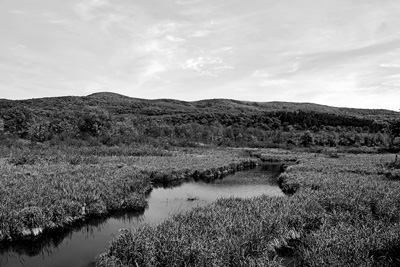News & Issues June 2015
From mountains to fertile swamp
Projects aim to preserve diverse swath of land at eastern edge of N.Y.
 By JOHN TOWNES
By JOHN TOWNES
Contributing writer
NEW LEBANON, N.Y.
The Shaker Swamp, which extends over nearly 500 acres in New Lebanon, is one of two areas that would be preserved from development under pending conservation projects in the town. John Townes photo
A pair of conservation projects now under way in New Lebanon aims to preserve a diverse swath of land along New York’s eastern border while also highlighting the town’s Shaker heritage and its pioneering role in the development of herbal medicines.
The two separate projects are intended to protect a large area of upland forests as well as lowland wetlands and meadows to the south of New Lebanon’s commercial center on Route 20.
In addition to protecting the environmental and scenic qualities of the largely undeveloped and biologically diverse area, the two projects are intended to open the land to public access for hiking and other forms of passive recreation.
Although the two projects are technically separate, they involve contiguous land areas and are connected in other ways. The combined site includes an area known as the Shaker Swamp, just south of the intersection of Routes 20 and 22. It extends east to Mount Lebanon.
Another section extends up the hillside to the upland forests around the former Shaker community on Mount Lebanon. That area is now the site of Darrow School, the Shaker Museum/Mount Lebanon and the Abode of the Message, a Sufi community and retreat center.
To the south, the planned conservation area extends into the town of Canaan to the campus of the Berkshire Farm Center and Services for Youth.
The projects also tie in with a larger overall effort by New York state, environmental organizations and others to protect land along the Taconic mountain range, which extends along the New England border from southern Vermont to northern Connecticut. This region contains one of the largest remaining areas of contiguous forest and natural habitat in the eastern United States.
“An overall goal is to preserve this landscape with large protected areas that are also linked by corridors to allow wildlife to travel between them,” said Tom Crowell, director of development and outreach with the Columbia Land Conservancy, a regional land preservation organization. “The section in New Lebanon is an important part of that.”
The two projects in New Lebanon are being pursued by a collaboration that includes the state Department of Environmental Conservation, the Columbia Land Conservancy, and the Shaker Swamp Conservancy, a community-based nonprofit group. Other organizations and supporters of the effort include private landowners and the Shaker Museum/Mount Lebanon.
One of the projects, known as the Mount Lebanon Forest Legacy Program, is using $1.9 million to buy conservation easements on about 1,300 acres of mainly forested upland. The funds are coming from the federal Forest Legacy Program, a national program run by the U.S. Forest Service that aims to protect environmentally significant forests that are vulnerable to development while keeping them open to careful timber management and harvesting.
The other project is being spearheaded by the local Shaker Swamp Conservancy. Its goal is to preserve the area known as the Shaker Swamp and open up key sections of this complex of wetlands and meadows to public access through a system of trails and boardwalks. This project also would include an educational component, with kiosks and other features to explain the environmental and historical features of the area.
A related goal is to create access points on the edges of the Shaker Swamp to connect with trails on the Forest Legacy lands.
Mineral springs, medicinal legacy
The combination of the two conservation areas ties together several aspects of the local environment and the history of New Lebanon.
The Shaker Swamp is considered a unique environmental resource, with a diverse ecosystem that includes a wide variety of vegetation, including rare plant species and herbs with natural medicinal qualities. It also is home to varied wildlife, including rare butterflies and dragonflies, among other species.
One reason for the swamp’s unusual characteristics is a natural thermal mineral springs located in the northern section of New Lebanon. These springs feed water into the swamp.
“The water has unique mineral qualities [and] is a consistent temperature throughout the year,” said David Stock, a board member of the Shaker Swamp Conservancy and president of the Shaker Museum/Mount Lebanon. “It contributes to unique growing conditions within the swamp.”
In the area’s earliest history, Native Americans, especially from the Mahican tribe, are said to have become proficient in using medicinal herbs from the swamp as natural remedies. White colonial settlement of the area began in the mid-18th Century.
From the 19th to the early 20th centuries, the Lebanon Springs were a major attraction for visitors. Several hotels and a spa were established in that part of town.
Another major influence on the town was the arrival of the Shaker religious sect in 1787. The Shakers established their largest and most prominent community in the United States in New Lebanon. At their peak, the Shakers owned 6,000 acres. They declined in the early 20th century and sold the last of their lands in 1947.
In the late 18th and early 19th centuries, the Mahicans taught the Shakers about medicinal herbs that grew in the swamp at the base of Mount Lebanon, and the Shakers developed a business cultivating and selling them. New Lebanon’s role in the medicinal herb industry was amplified in 1824, when a member of the Tilden family, which had a farm adjacent to Shaker land, founded the Tilden Company, which is believed to be the first pharmaceutical company in the United States.
Using techniques learned from the Shakers, the Tilden Company cultivated and sold herbal medicines on a large scale. It produced these medicines using indigenous plants as well as some it imported to the area. The Tilden Company, which also branched out into producing other forms of medicine, remained a mainstay of the local economy until 1961, when it closed.
Vestiges of this history of producing herbal medicines, including old stone walls and the remains of other Shaker structures, can be found in the Shaker Swamp.
Conserving a mountainside
The local Forest Legacy project was started around 2005 by the Columbia Land Conservancy. It is being administered by the state Department of Environmental Conservation, which is handling the purchase the conservation easements within the project area.
In 2011, organizers of the project submitted a funding application to the Forest Legacy Program, and the funding was virtually secured when the project was ranked ninth out of 69 Forest Legacy applications the U.S. Forest Service received from 42 states.
After some concern that the money would be lost when Congress slashed funding for the overall Forest Legacy Program, the funds for the New Lebanon project actually were allocated in 2013.
Now the state is in the midst of negotiations with individual property owners to purchase conservation easements for the project. The landowners include Darrow School (a private preparatory school), the Abode of the Message (a Sufi community and headquarters of the Sufi Order International North America), and Berkshire Farm Center and Services for Youth (a therapeutic treatment center and school for adolescents). In addition, private landowners John and Brenda Adams are selling easements to the Forest Legacy project.
The landowners will retain ownership of their properties. The easements impose conservation restrictions on the land, limiting future development, and allow for the creation of public-access corridors with trails. The easements do allow for continued use of the land, including some new construction and timber harvesting, by its owners.
The parties involved have reached basic agreements in principle. However, the negotiations are still under way, and final agreements have not been reached.
Darrow School, for example, is currently waiting for the details of the price and other conditions regarding access, restrictions and other conditions, said Craig Westcott, who is Darrow’s assistant head of school for advancement and external relations as well as the school’s sustainability coordinator.
“We would love to do this in principle, but we can’t commit to anything until we know more specifics of the assessment and conditions,” Westcott said. “When we have that, the board will determine whether it is in the best interests of the school.”
Westcott emphasized that Darrow has a fundamental commitment to environmental sustainability and historic preservation and already manages its lands based on these goals.
Regardless of whether the Forest Legacy project is completed, he said, “we have very intent to continue to manage our land as we have, and we’re always willing to listen and work with other groups to achieve those goals.”
Protecting a swamp
Meanwhile, the effort to preserve the Shaker Swamp is moving into a new phase.
The Shaker Swamp Conservancy has established a set of overall goals, including trails and boardwalks through important areas of the swamp, as well as kiosks and other educational elements.
“We have developed the conceptual plan for what we want to do,” Stock said. “Now we are focused on the details of what specifically we can achieve and the time frame.”
In April, the organization received its first donation of land, a 39-acre parcel along Route 22 that was given to it by Amy Schirmer of Pittsfield, Mass., whose parents had acquired it in the 1980s.
The Shaker Swamp project was initiated in 2006 by a group of local residents who believed that the swamp was an important but underappreciated resource. They raised seed money and launched a series of environmental and historical research projects to document the importance of the area.
Ted Timreck, a filmmaker and researcher who owns a home in New Lebanon and works for the Smithsonian Institute, produced a full-length digital video to help raise awareness of the swamp and its historic legacy.
The group also met with landowners and others in the community to build support. They formed the Shaker Swamp Conservancy as a nonprofit organization in 2012. They have also been coordinating their efforts with the Forest Legacy project.
Although the exact boundaries of the Shaker Swamp are open to interpretation, the organization’s Web site (shakerswamp.org) defines the overall area as 495 acres. Darrow School owns a large section of that, and other private individuals and businesses own the rest.
The sections that are designated as wetlands are inherently protected from development, but there are areas along the edges and within the swamp area that the group fears could be vulnerable.
The goal of the conservancy is to preserve as much of the area as possible, and provide public access to it, through a combination of donations and acquisitions, conservation easements and other arrangements.
Organizers emphasize that the overall plan is based on voluntary actions, and the conservancy has been in discussions with property owners on an ongoing basis to consider possible arrangements.
“We’re looking at protecting key parcels to connect the dots -- and whatever else we can do to preserve the overall area,” explained John Dax, the Shaker Swamp Conservancy’s board president.
The swamp and Forest Legacy projects also reflect other ongoing initiatives to highlight New Lebanon’s legacy and to make the town more of a destination for visitors.
In April, the Department of Environmental Conservation officially opened a new 518-acre Hand Hollow state forest in southwestern New Lebanon, with entrances on Gale Hill Road and County Route 9. The Hand Hollow forest is managed for multiple uses, including recreation, timber production, watershed protection and wildlife habitat.
Another initiative, called Behold New Lebanon, is entering its second year. That program, described as a “living museum,” involves offering organized visits to local businesses and residents who are engaged in various crafts and enterprises.
There is also a plan under way to extend the Corkscrew Rail Trail, which is being developed on a long-abandoned railroad corridor in Stephentown and Petersburg, southward into New Lebanon.

